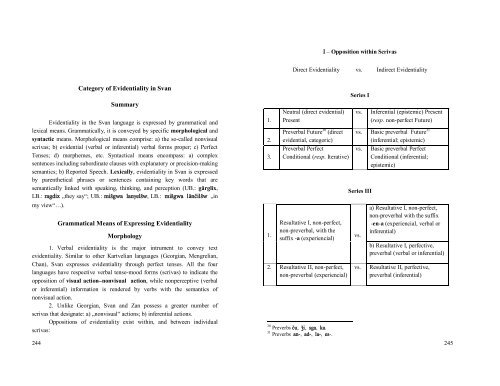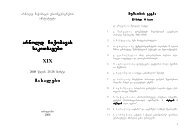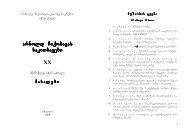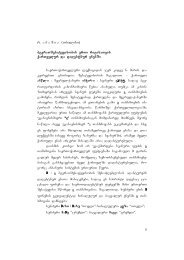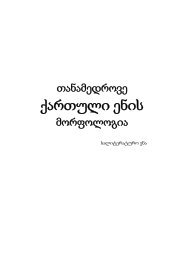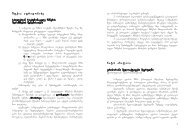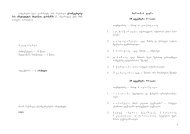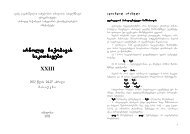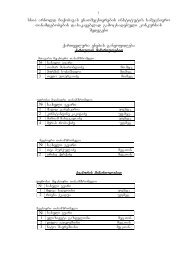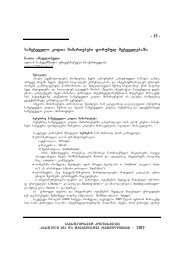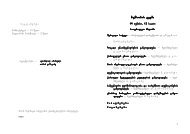fwjefodjbmpcjt!lbufhpsjb! twbovs!fobTj
fwjefodjbmpcjt!lbufhpsjb! twbovs!fobTj
fwjefodjbmpcjt!lbufhpsjb! twbovs!fobTj
Create successful ePaper yourself
Turn your PDF publications into a flip-book with our unique Google optimized e-Paper software.
I – Opposition within Scrivas<br />
Direct Evidentiality vs. Indirect Evidentiality<br />
244<br />
Category of Evidentiality in Svan<br />
Summary<br />
Evidentiality in the Svan language is expressed by grammatical and<br />
lexical means. Grammatically, it is conveyed by specific morphological and<br />
syntactic means. Morphological means comprise: a) the so-called nonvisual<br />
scrivas; b) evidential (verbal or inferential) verbal forms proper; c) Perfect<br />
Tenses; d) morphemes, etc. Syntactical means encompass: a) complex<br />
sentences including subordinate clauses with explanatory or precision-making<br />
semantics; b) Reported Speech. Lexically, evidentiality in Svan is expressed<br />
by parenthetical phrases or sentences containing key words that are<br />
semantically linked with speaking, thinking, and perception (UB.: gärglix,<br />
LB.: ragdix „they say“; UB.: miSgwa lanGelSw, LB.: miSgwa länCilSw „in<br />
my view“…).<br />
Grammatical Means of Expressing Evidentiality<br />
Morphology<br />
1. Verbal evidentiality is the major intrument to convey text<br />
evidentiality. Similar to other Kartvelian languages (Georgian, Mengrelian,<br />
Chan), Svan expresses evidentiality through perfect tenses. All the four<br />
languages have respective verbal tense-mood forms (scrivas) to indicate the<br />
opposition of visual action–nonvisual action, while nonperceptive (verbal<br />
or inferential) information is rendered by verbs with the semantics of<br />
nonvisual action.<br />
2. Unlike Georgian, Svan and Zan possess a greater number of<br />
scrivas that designate: a) „nonvisual“ actions; b) inferential actions.<br />
Oppositions of evidentiality exist within, and between individual<br />
scrivas:<br />
1.<br />
2.<br />
3.<br />
1.<br />
Neutral (direct evidential)<br />
Present<br />
Preverbal Future 30 (direct<br />
evidential, categoric)<br />
Preverbal Perfect<br />
Conditional (resp. Iterative)<br />
Resultative I, non-perfect,<br />
non-preverbal, with the<br />
suffix -a (experiencial)<br />
2. Resultative II, non-perfect,<br />
non-preverbal (experiencial)<br />
30 Preverbs Cu, Ji, sga, qa.<br />
31 Preverbs an-, ad-, la-, es-.<br />
Series I<br />
vs.<br />
Inferential (epistemic) Present<br />
(resp. non-perfect Future)<br />
vs. Basic preverbal Future 31<br />
vs.<br />
Series III<br />
vs.<br />
vs.<br />
(inferential; epistemic)<br />
Basic preverbal Perfect<br />
Conditional (inferential;<br />
epistemic)<br />
a) Resultative I, non-perfect,<br />
non-preverbal with the suffix<br />
-en-a (experiencial, verbal or<br />
inferential)<br />
b) Resultative I, perfective,<br />
preverbal (verbal or inferential)<br />
Resultative II, perfective,<br />
preverbal (inferential)<br />
245


